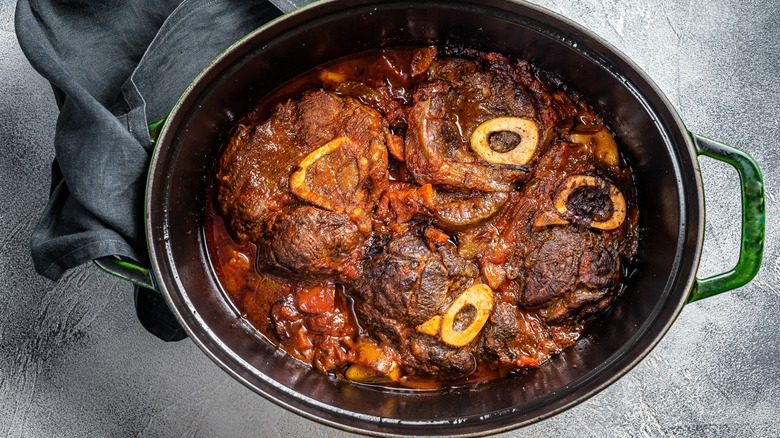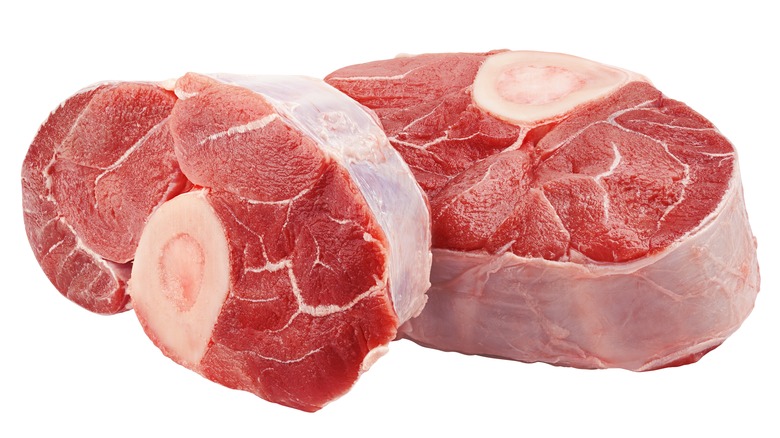Why Braising Is The Only Way Beef Shank Should Ever Be Cooked
Not every cut of beef is a steak, and there's a beauty to that. Sure, a nice slab of meat grilled or seared to perfection is a delicious creation; however some deft cooking techniques can showcase a different type of meat satiation. A terrific example are beef shanks, a cut from the upper leg. Cook them quickly, and it's a tough, chewy, and generally unpalatable experience. However, braise the shanks, and they transform into a culinary treat.
Time and liquid do wonders on the composition of the cut, making them tender and full of flavor. Their contained collagen creates a decadent mouthfeel, which also readily infuses aromatics. Crafted with care, it'll be a beef centerpiece that turns heads more than some steaks. And throw in the fact it's generally an affordable cut, and it's easy to see why beef shanks are such a move.
Their collagen-rich nature also makes them one of the best beef cuts for rich, savory Pho and other stock bases. However, while such dishes are flavorful, they won't showcase the texture of the beef shanks. So if you really want to experience the terrific meatiness of the cut, then braising is the optimal preparation method every time.
Beef shank's tough texture transforms when slow cooked
Beef shanks come from the legs, and are sourced from both the front and rear thighs, accordingly labeled front shank and hind shake. The latter is larger, and more consistent in size, which makes it more popular. Since they're butchered from a part of the animal in frequent motion, shanks are muscular — and therefore take on a much tougher consistency. You'll find them sliced into cross-cuts, with bone, muscle, and tissue intact.
Nevertheless, cook the beef with patience, and all that collagen is an advantage instead. Braised beef shank is both delectably tender and flavorful. The bone marrow as well as gelatin from the cut meld into the sauce, creating a rich consistency and taste. As a result, the once tough meat easily shreds, and turns into a delicious bite.
As with other braised dishes, adding a liquid like broth, wine, or water is essential. The introduced moisture softens the beef, and is the vessel for collagen's tenderizing properties. Over three to four hours of patient slow-cooking, the protein melts and turns into gelatin, giving beef shanks their special melt-in-the-mouth consistency.
Braise beef shanks in a variety of dishes
The process of braising follows a similar format: season and sear the meat, add in aromatics, then cover with liquid and slow cook for hours. With such a straightforward creation process, there are many possible flavoring variations. Perhaps the best-known rendition is Northern Italy's Osso Buco, which slowly cooks veal shanks in white wine, broth, root vegetables and aromatics, all topped with a parsley-based gremolata. It's a rich and fragrant dish that turns out delectably in a pressure cooker, or can be braised in the oven, too.
This classic is easy to riff off: substitute red wine and adjust the herbs for an even more savory take. Aromatics like onions, carrots, garlic and herbs are dependable additions; they're a perfect accompaniment to the shanks. And if you're not feeling a chunky sauce, you can always take out the beef and immersion blend to completion.
Outside of such European-inspired recipes, beef shanks braising is also a common preparation method in Taiwanese and Chinese cooking. There, recipes involve a greater amount of liquid, flavored with additions such as ginger, green onions, and the fragrant Chinese five spice blend. Rather than pulling apart the beef, the shanks are sliced into thin, tender slices, making them an ideal topping for noodles and rice bowls. So, whichever way you slow cook, know that the beef terrifically absorbs many various flavors.


